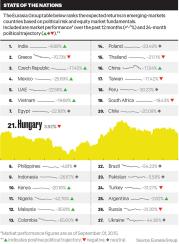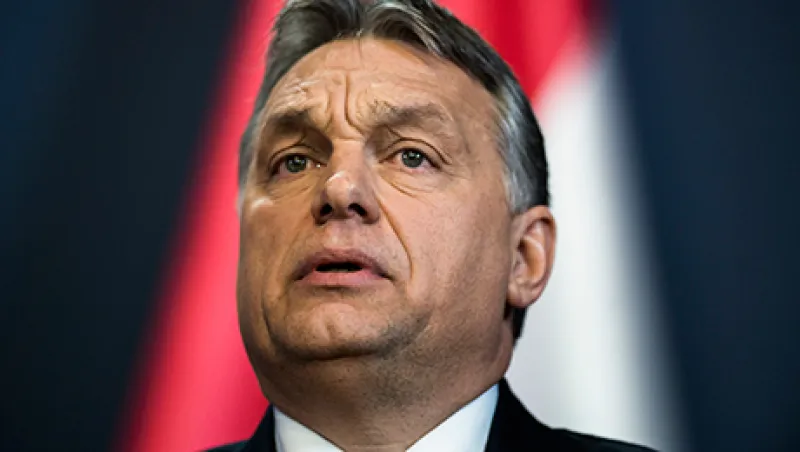Amid the biggest wave of migration since World War II, more than 140,000 refugees fleeing civil wars, terrorism and economic strife have applied for asylum in Hungary so far this year, a threefold increase from 2014. Unlike many of its European Union partners, Hungary has greeted the migrants with intolerance and violence. Prime Minister Viktor Orbán and his right-wing Fidesz administration made headlines in September when authorities used razor wire fencing to seal the country’s borders with Serbia and Croatia and employed tear gas and water cannons against fence jumpers. Hungary was pressured to reopen its main border-crossing station with Serbia on September 20.
Hungary has always stuck out for being a particularly nationalist country with a strong right-wing government that has expressed a fair degree of xenophobia, says L. Bryan Carter, head of fixed-income strategy at Boston-based Acadian Asset Management and lead portfolio manager for the emerging-markets debt strategy. But in 2004 international investors were pleased when, upon joining the European Union, Hungary softened its tone. That, coupled with Orbán’s strong growth policy since taking office in 2010, has reinforced political and economic stability. Rising nationalism and radicalization in response to the refugees could hurt economic prospects.

“Investor confidence is currently rather high, supported by decent economic data, recovery after some more challenging years following the global financial crisis and the moderation of the policy course,” says Gunter Deuber, head of Central and Eastern Europe research at Raiffeisen Bank International in Vienna. Foreign direct and portfolio investments amount to 85 percent and 44 percent of gross domestic product, respectively, says Dominique Fruchter, a senior economist at Paris-based credit insurance company Coface. Hungary’s economic growth was the strongest among major Central and Eastern European countries last year, at 3.6 percent, while economic activity softened in broader Europe.
“A lot of this has been made possible by incredibly easy monetary policy,” says Acadian’s Carter. Orbán was criticized by political rivals and the European Central Bank for tucking the central bank, as well as the judiciary and media, under state control, but the result has been more dovish policymaking. An aggressive easing of interest rates to 1.35 percent in September from 7 percent in late 2012 has enabled the administration to finance the stimulus.
The migrant crisis has thrown a wrench into the works, though. Growth has been decelerating this year — the International Monetary Fund forecasts expansion of 2.7 percent this year and 2.3 percent in 2016, a bit behind the regional average — and declining popularity versus far-right opposition party Jobbik prompted Orbán’s Fidesz party to adopt a hard line in the face of the surge of refugees.
“It’s too early to note any immediate economic implications of the migrant crisis or an increase in the risk awareness from financial market investors,” says Ricardo Adrogué, head of emerging-markets debt at Springfield, Massachusetts–based Babson Capital Management. Yet a radicalization of policies could turn away investors.
The irony, says Carter, is that “Hungary is the perfect market to absorb these migrants.” The country’s population is shrinking by a half percent every year, and the labor force is contracting faster as it ages, he explains. Cheap, qualified migrant labor could feed growth in Hungary’s manufacturing industry and boost the growth rate by 0.1 to 0.2 percentage point, Raiffeisen’s Deuber estimates. Locals are less enthusiastic about the influx of potential workers. Though better labor market conditions, propelled by a boom in state-financed construction programs and manufacturing, have slashed unemployment, the figure remains relatively high at 7.7 percent.
“The short-term and medium-term effects depend on how the administration integrates refugees,” Deuber continues. Government spending on housing, provisions, social benefits and pensions for refugees will strain the budget. Hungary’s debt is 81 percent of GDP and declining, while the deficit is fairly well contained at about 2.5 percent of GDP.
International fears of political and economic radicalization in Hungary may be exaggerated: Refugees entering Hungary — mainly from Afghanistan, Iraq and Syria — are expected to more than double by year-end, to 300,000, but 95 percent of them are using the country as a stepping-stone to the more prosperous west, particularly Germany, says the International Organization for Migration.





